Experimental Investigation on Ternary Blended Recycled Aggregate Concrete Using Glass Fibers
Abstract
:1. Introduction

2. Materials and Methods
3. Mix Proportion and Designation
4. Results and Discussion
4.1. Workability
4.2. Compressive Strength
4.3. Split Tensile Strength
4.4. Correlation between Compressive Strength and Tensile Splitting Strength
4.5. Relationship between Split Tensile Strength and Compressive Strength
(28 days, for both plain and GFRC mixes,
for plain concrete, take Glass fiber, GF = 0)
| Type of Concrete | Split Tensile Strength (fsp) | Flexural Strength (fb) |
|---|---|---|
| Plain concrete | [37] | fb = 0.62 × (fc)0.5 [37] |
| fsp = 0.19 × fc0.75 [41] | fb = 0.81 × (fc)0.5 [42] | |
| fsp = 0.301 × (0.8fc)0.65 [40] | fb = 0.70 × (fc)0.5 [43] | |
| GFRC | fsp = 0.8fc/(0.1 × (0.8fc) + 7.11) [44] | - |
| fsp = 0.60 × (0.8fc)0.5 [45] | fb = 0.94 × (0.8fc)0.5 [46] | |
| fsp = 0.09 × fc + 0.025 [38] | fb = 0.11 × fc + 0.39 [38] |
| Experimental | Predicted fsp (MPa) | ||||||||
|---|---|---|---|---|---|---|---|---|---|
| fc (MPa) | fsp (MPa) | Equation (1) | Equation (2) | ACI [37] | GB [41] | Iravani [40] | Choi and Yuan [45] | Ali and Qureshi [38] | Zain et al. [44] |
| 54.13 | 4.69 | 4.45 | 4.64 | 4.05 | 3.79 | 3.49 | 3.95 | 4.90 | 3.79 |
| 56.54 | 4.95 | 4.74 | 4.83 | 4.14 | 3.92 | 3.59 | 4.04 | 5.11 | 3.89 |
| 53.69 | 4.73 | 4.52 | 4.61 | 4.03 | 3.77 | 3.47 | 3.93 | 4.86 | 3.77 |
| 51.84 | 4.4 | 4.36 | 4.46 | 3.96 | 3.67 | 3.39 | 3.86 | 4.69 | 3.68 |
| 54.32 | 4.65 | 4.65 | 4.66 | 4.05 | 3.80 | 3.49 | 3.96 | 4.91 | 3.79 |
| 51.49 | 4.43 | 4.43 | 4.44 | 3.95 | 3.65 | 3.37 | 3.85 | 4.66 | 3.67 |
| 49.24 | 4.21 | 4.25 | 4.26 | 3.86 | 3.53 | 3.28 | 3.77 | 4.46 | 3.57 |
| 53.17 | 4.45 | 4.60 | 4.57 | 4.01 | 3.74 | 3.45 | 3.91 | 4.81 | 3.74 |
| 48.85 | 4.27 | 4.31 | 4.23 | 3.84 | 3.51 | 3.26 | 3.75 | 4.42 | 3.55 |
| 47.08 | 4.12 | 4.15 | 4.09 | 3.77 | 3.41 | 3.18 | 3.68 | 4.26 | 3.46 |
| 51.38 | 4.27 | 4.52 | 4.43 | 3.94 | 3.65 | 3.37 | 3.85 | 4.66 | 3.66 |
| 46.12 | 4.1 | 4.19 | 4.01 | 3.74 | 3.36 | 3.14 | 3.64 | 4.18 | 3.42 |
| IAE (%) | 2.44 | 1.61 | 11.14 | 17.75 | 24.01 | 13.29 | 4.97 | 17.44 | |
4.6. Flexural Strength
4.7. Relationship between Flexural Strength and Compressive Strength
(28 days, for both plain and GFRC mixes,
for plain concrete, take Glass fiber, GF = 0)
5. Conclusions
- Water absorption tests and durability studies, such as acid attack tests using different acids, can be conducted.
- Mechanical properties of concrete can be evaluated with different water-cement ratios, different binder content, and with different grades of concrete.
- Behavior of beams under static and dynamic loading can be evaluated.
- A layer of slab can be cast and evaluated for their temperature stress variation at different positions.
- Further research can be completed by evaluating their behavior in pre-cast concrete applications.
Author Contributions
Funding
Data Availability Statement
Acknowledgments
Conflicts of Interest
References
- El-Hassan, H.; Kianmehr, P.; Zouaoui, S. Properties of pervious concrete incorporating recycled concrete aggregates and slag. Constr. Build. Mater. 2019, 212, 164–175. [Google Scholar] [CrossRef]
- Tüfekçi, M.M.; Çakır, Ö. An Investigation on Mechanical and Physical Properties of Recycled Coarse Aggregate (RCA) Concrete with GGBFS. Int. J. Civ. Eng. 2017, 15, 549–563. [Google Scholar] [CrossRef]
- Habibi, A.; Ramezanianpour, A.M.; Mahdikhani, M.; Bamshad, O. RSM-based evaluation of mechanical and durability properties of recycled aggregate concrete containing GGBFS and silica fume. Constr. Build. Mater. 2021, 270, 121431. [Google Scholar] [CrossRef]
- Majhi, R.; Nayak, A. Bond, durability and microstructural characteristics of ground granulated blast furnace slag based recycled aggregate concrete. Constr. Build. Mater. 2019, 212, 578–595. [Google Scholar] [CrossRef]
- Gómez-Soberón, J.M.V. Porosity of recycled concrete with substitution of recycled concrete aggregate: An experimental study. Cem. Concr. Res. 2002, 32, 1301–1311. [Google Scholar] [CrossRef] [Green Version]
- Yehia, S.; Helal, K.; Abusharkh, A.; Zaher, A.; Istaitiyeh, H. Strength and Durability Evaluation of Recycled Aggregate Concrete. Int. J. Concr. Struct. Mater. 2015, 9, 219–239. [Google Scholar] [CrossRef] [Green Version]
- Kisku, N.; Joshi, H.; Ansari, M.; Panda, S.; Nayak, S.; Dutta, S.C. A critical review and assessment for usage of recycled aggregate as sustainable construction material. Constr. Build. Mater. 2017, 131, 721–740. [Google Scholar] [CrossRef]
- Spanish Minister of Public Works. Instrucción de Hormigón Estructural EHE_08 (Spanish Structural Concrete Code); Spanish Minister of Public Works: Madrid, Spain, 2008; Volume Act 1247/2.
- Hansen, T.C. Recycled aggregates and recycled aggregate concrete second state-of-the-art report developments 1945–1985. Mater. Struct. 1986, 19, 201–246. [Google Scholar] [CrossRef]
- Matsagar, V. Advances in Structural Engineering. In Advances in Structural Engineering: Materials; Matsagar, V., Ed.; Springer: New Delhi, India, 2015; Volume 3, pp. 1619–2647. [Google Scholar] [CrossRef]
- IS-383-2016; Coarse and Fine Aggregate for Concrete-Specification. Bureau of Indian Standards: New Delhi, India, 2016.
- Martín-Morales, M.; Zamorano, M.; Ruiz-Moyano, A.; Valverde-Espinosa, I. Characterization of recycled aggregates construction and demolition waste for concrete production following the Spanish Structural Concrete Code EHE-08. Constr. Build. Mater. 2011, 25, 742–748. [Google Scholar] [CrossRef]
- Karthik, C.; Nagaraju, A. An Experimental Study on Recycled Aggregate Concrete with Partial Replacement of Cement with Flyash and Alccofine. IOP Conf. Ser. Earth Environ. Sci. 2023, 1130, 012012. [Google Scholar] [CrossRef]
- Kavyateja, B.V.; Jawahar, J.G.; Sashidhar, C. Effectiveness of alccofine and fly ash on mechanical properties of ternary blended self compacting concrete. Mater. Today Proc. 2020, 33, 73–79. [Google Scholar] [CrossRef]
- Kumar, S.; Kumar, R.; Bandopadhyay, A.; Alex, T.; Kumar, B.R.; Das, S.; Mehrotra, S. Mechanical activation of granulated blast furnace slag and its effect on the properties and structure of portland slag cement. Cem. Concr. Compos. 2008, 30, 679–685. [Google Scholar] [CrossRef]
- El Nouhy, H.A. Properties of paving units incorporating slag cement. HBRC J. 2013, 9, 41–48. [Google Scholar] [CrossRef] [Green Version]
- Swarna Swetha, K.; Tezeswi, T.P.; Siva Kumar, M.V.N. Implementing construction waste management in India: An extended theory of planned behaviour approach. Environ. Technol. Innov. 2022, 27, 1–16. [Google Scholar] [CrossRef]
- IS:455-2015; Portland Slag Cement-Specification. Bureau of Indian Standards: New Delhi, India, 2015.
- ASTM C989-1999; Standard Specification for Ground Granulated Blast-Furnace Slag for Use in Concrete and Mortars. American Society for Testing and Materials: West Conshohocken, PA, USA, 2006.
- ASTM C494/C949M-19; Standard Specification for Chemical Admixtures for Concrete. American Society for Testing and Materials: West Conshohocken, PA, USA, 2005.
- Sruthi, S.; Gayathri, V. Synthesis and Evaluation of Eco-Friendly, Ambient-Cured, Geopolymer-Based Bricks Using Industrial By-Products. Buildings 2023, 13, 510. [Google Scholar] [CrossRef]
- IS-10262-2019; Concrete Mix Proportioning-Guidelines. Bureau of Indian Standards: New Delhi, India, 2019.
- Srinath, B.S.; Patnaikuni, C.K.; Balaji, K.; Kumar, B.S.; Manjunatha, M. A prospective review of alccofine as supplementary cementitious material. Mater. Today Proc. 2021, 47, 3953–3959. [Google Scholar] [CrossRef]
- IS-516-1959; Method of Tests for Strength of Concrete. Bureau of Indian Standards: New Delhi, India, 1959.
- El Ouni, M.H.; Shah, S.H.A.; Ali, A.; Muhammad, S.; Mahmood, M.S.; Ali, B.; Marzouki, R.; Raza, A. Mechanical performance, water and chloride permeability of hybrid steel-polypropylene fiber-reinforced recycled aggregate concrete. Case Stud. Constr. Mater. 2022, 16, e00831. [Google Scholar] [CrossRef]
- Ali, B.; Qureshi, L.A.; Shah, S.H.A.; Rehman, S.U.; Hussain, I.; Iqbal, M. A step towards durable, ductile and sustainable concrete: Simultaneous incorporation of recycled aggregates, glass fiber and fly ash. Constr. Build. Mater. 2020, 251, 118980. [Google Scholar] [CrossRef]
- Li, X. Recycling and reuse of waste concrete in China. Part I. Material behaviour of recycled aggregate concrete. Resour. Conserv. Recycl. 2008, 53, 36–44. [Google Scholar] [CrossRef]
- Boobalan, S.; Srivatsav, V.A.; Nisath, A.M.T.; Babu, A.P.; Gayathri, V. A comprehensive review on strength properties for making Alccofine based high performance concrete. Mater. Today Proc. 2021, 45, 4810–4812. [Google Scholar] [CrossRef]
- Mas, B.; Cladera, A.; del Olmo, T.; Pitarch, F. Influence of the amount of mixed recycled aggregates on the properties of concrete for non-structural use. Constr. Build. Mater. 2012, 27, 612–622. [Google Scholar] [CrossRef]
- Kazmi, S.M.S.; Munir, M.J.; Wu, Y.-F.; Patnaikuni, I. Effect of macro-synthetic fibers on the fracture energy and mechanical behavior of recycled aggregate concrete. Constr. Build. Mater. 2018, 189, 857–868. [Google Scholar] [CrossRef]
- Ali, B.; Qureshi, L.A. Durability of recycled aggregate concrete modified with sugarcane molasses. Constr. Build. Mater. 2019, 229, 116913. [Google Scholar] [CrossRef]
- Alnahhal, W.; Aljidda, O. Flexural behavior of basalt fiber reinforced concrete beams with recycled concrete coarse aggregates. Constr. Build. Mater. 2018, 169, 165–178. [Google Scholar] [CrossRef]
- Xie, J.; Kou, S.-C.; Ma, H.; Long, W.-J.; Wang, Y.; Ye, T.-H. Advances on properties of fiber reinforced recycled aggregate concrete: Experiments and models. Constr. Build. Mater. 2021, 277, 122345. [Google Scholar] [CrossRef]
- Çakır, O. Experimental analysis of properties of recycled coarse aggregate (RCA) concrete with mineral additives. Constr. Build. Mater. 2014, 68, 17–25. [Google Scholar] [CrossRef]
- Duan, Z.; Poon, C.S. Properties of recycled aggregate concrete made with recycled aggregates with different amounts of old adhered mortars. Mater. Des. 2014, 58, 19–29. [Google Scholar] [CrossRef]
- Kou, S.-C.; Poon, C.S. Long-term mechanical and durability properties of recycled aggregate concrete prepared with the incorporation of fly ash. Cem. Concr. Compos. 2013, 37, 12–19. [Google Scholar] [CrossRef]
- ACI Committee; American Concrete Institute. Building Code Requirements for Structural Concrete (ACI 318-08) and Commentary; American Concrete Institute: Farmington Hills, MI, USA, 2007; Volume 2007. [Google Scholar]
- Ali, B.; Qureshi, L.A. Combined Effect of Fly Ash and Glass Fibers on Mechanical Performance of Concrete. NED Univ. J. Res. 2018, 15, 91–100. [Google Scholar]
- González-Fonteboa, B.; Martínez-Abella, F. Concretes with aggregates from demolition waste and silica fume. Materials and mechanical properties. Build. Environ. 2008, 43, 429–437. [Google Scholar] [CrossRef]
- Iravani, S. Mechanical Properties of High-Performance Concrete; American Concrete Institute/ACI Special Publication: Farmington Hills, MI, USA, 2010; Volume SP-128, pp. 416–426. [Google Scholar] [CrossRef]
- GB 50010-2010; Chinese Standard Code for Design of Concrete Structures. MOHURD: Beijing, China, 2015.
- Du Beton, C.E.-I. CEB-FIP Model Code 2010; CEB-FIP: Lausanne, Switzerland, 2012. [Google Scholar]
- IS 456; Plain Concrete and Reinforced. Bureau of Indian Standards: New Delhi, India, 2000.
- Zain, M.; Mahmud, H.; Ilham, A.; Faizal, M. Prediction of splitting tensile strength of high-performance concrete. Cem. Concr. Res. 2002, 32, 1251–1258. [Google Scholar] [CrossRef]
- Choi, Y.; Yuan, R.L. Experimental relationship between splitting tensile strength and compressive strength of GFRC and PFRC. Cem. Concr. Res. 2005, 35, 1587–1591. [Google Scholar] [CrossRef]
- Hilles, M.M.; Ziara, M.M. Mechanical behavior of high strength concrete reinforced with glass fiber. Eng. Sci. Technol. Int. J. 2019, 22, 920–928. [Google Scholar] [CrossRef]
- Ajdukiewicz, A.; Kliszczewicz, A. Influence of recycled aggregates on mechanical properties of HS/HPC. Cem. Concr. Compos. 2002, 24, 269–279. [Google Scholar] [CrossRef]
- Bairagi, N.; Ravande, K.; Pareek, V. Behaviour of concrete with different proportions of natural and recycled aggregates. Resour. Conserv. Recycl. 1993, 9, 109–126. [Google Scholar] [CrossRef]
- Prasad, M.L.; Rathish, K.P. Strength Studies on Glass Fiber Reinforced Recycled Aggregate Concrete. Asian J. Civ. Eng. Build. Hous. 2007, 8, 677–690. [Google Scholar]
- Meesala, C.R. Influence of different types of fiber on the properties of recycled aggregate concrete. Struct. Concr. 2019, 20, 1656–1669. [Google Scholar] [CrossRef]

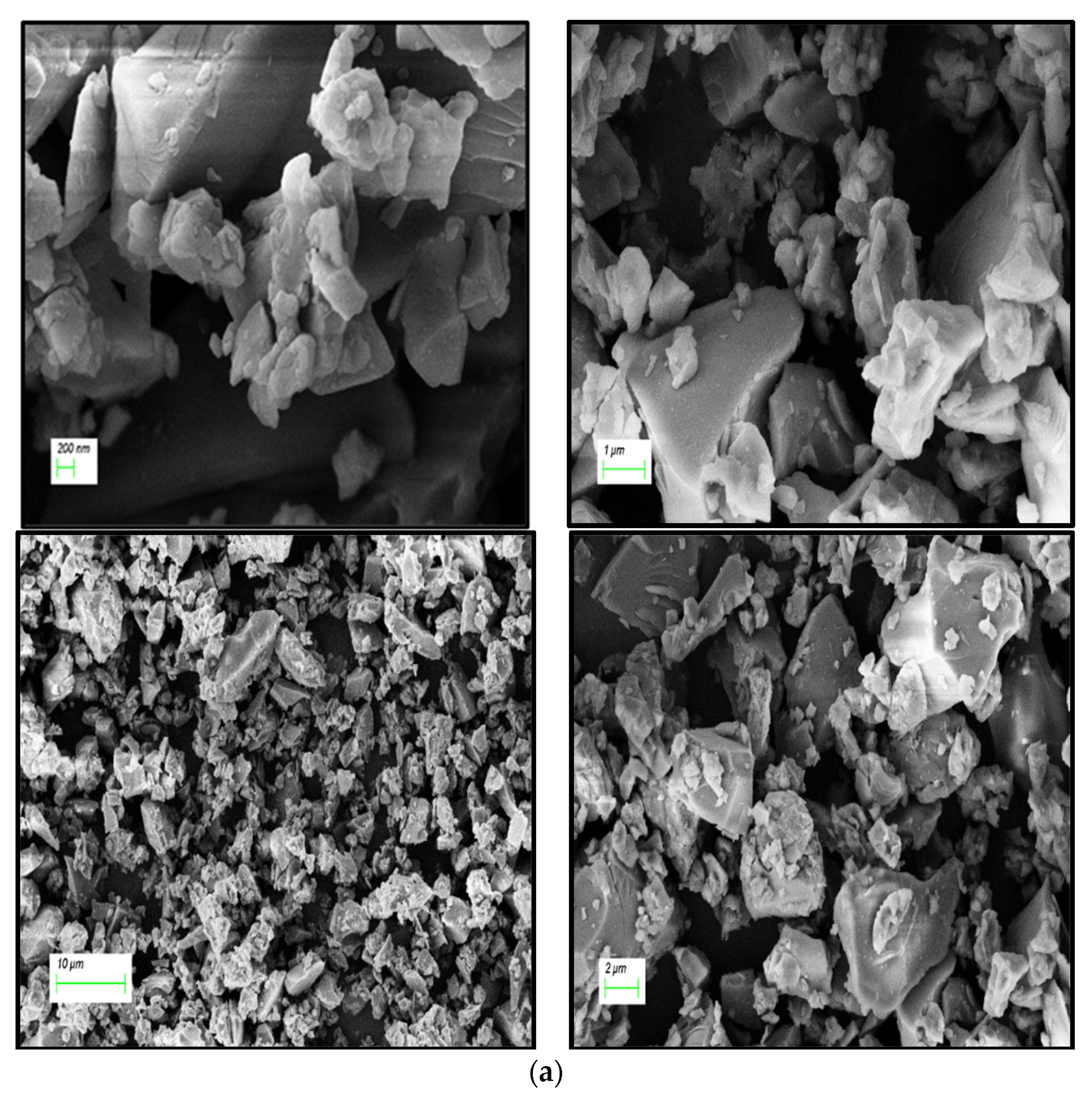

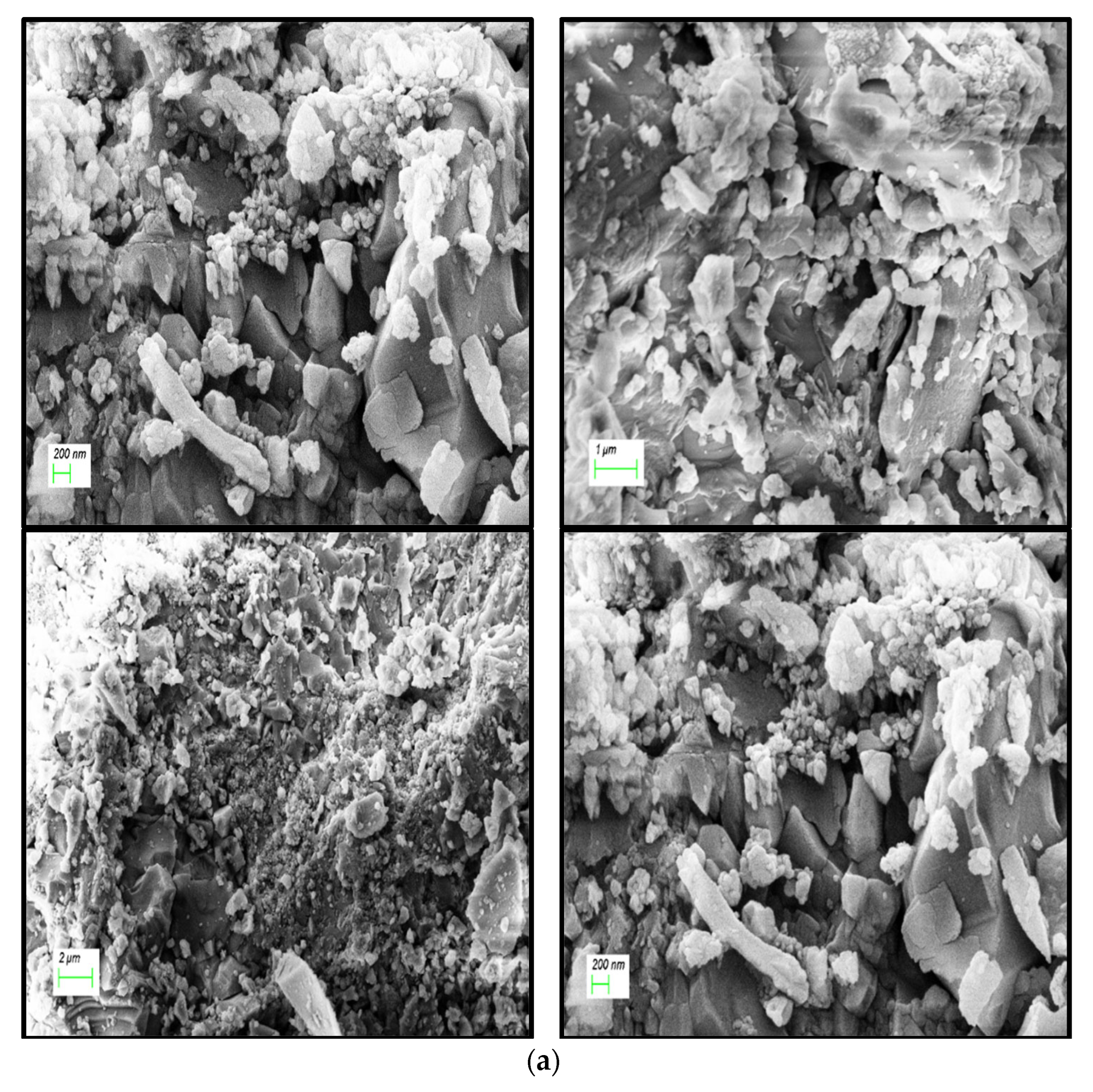


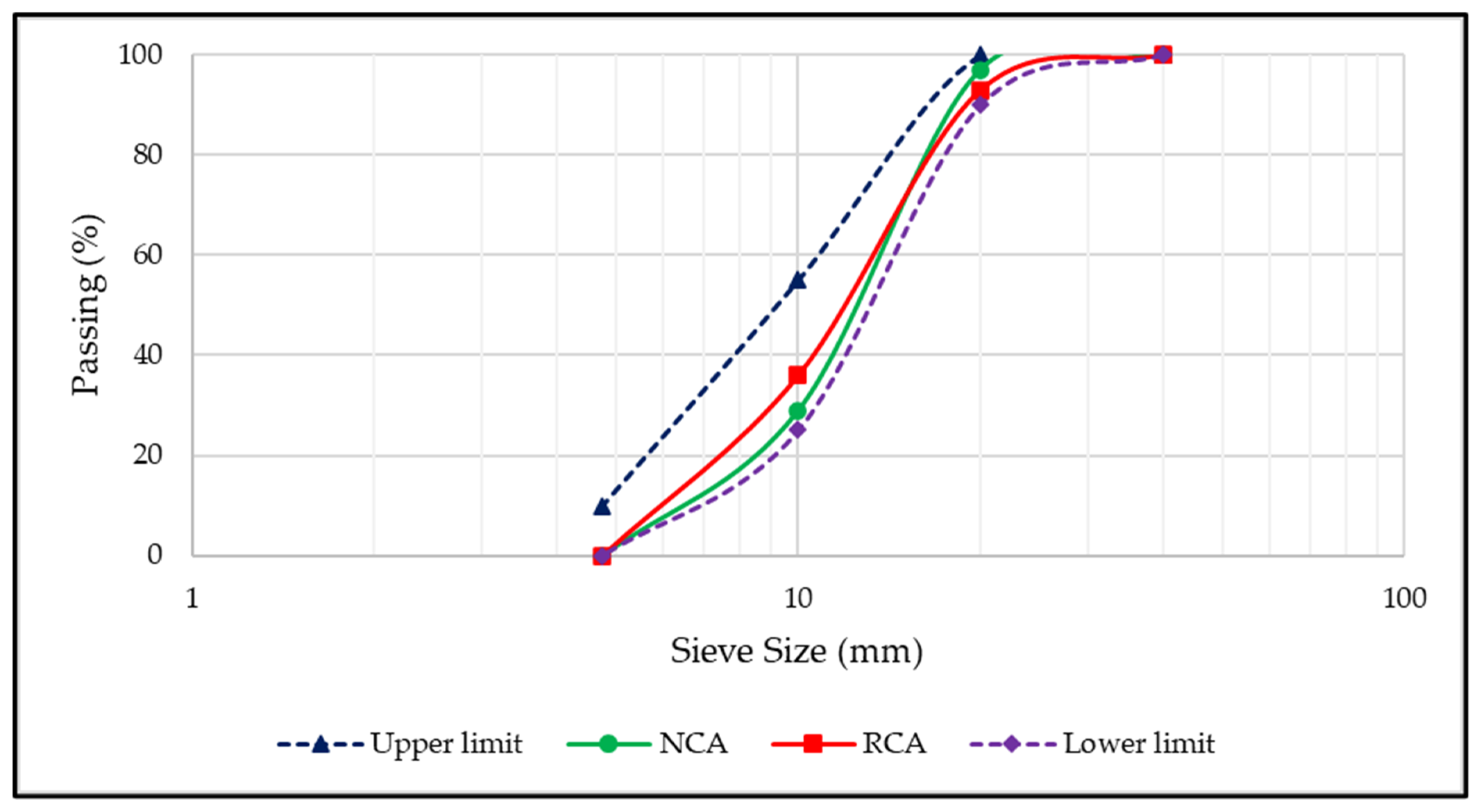
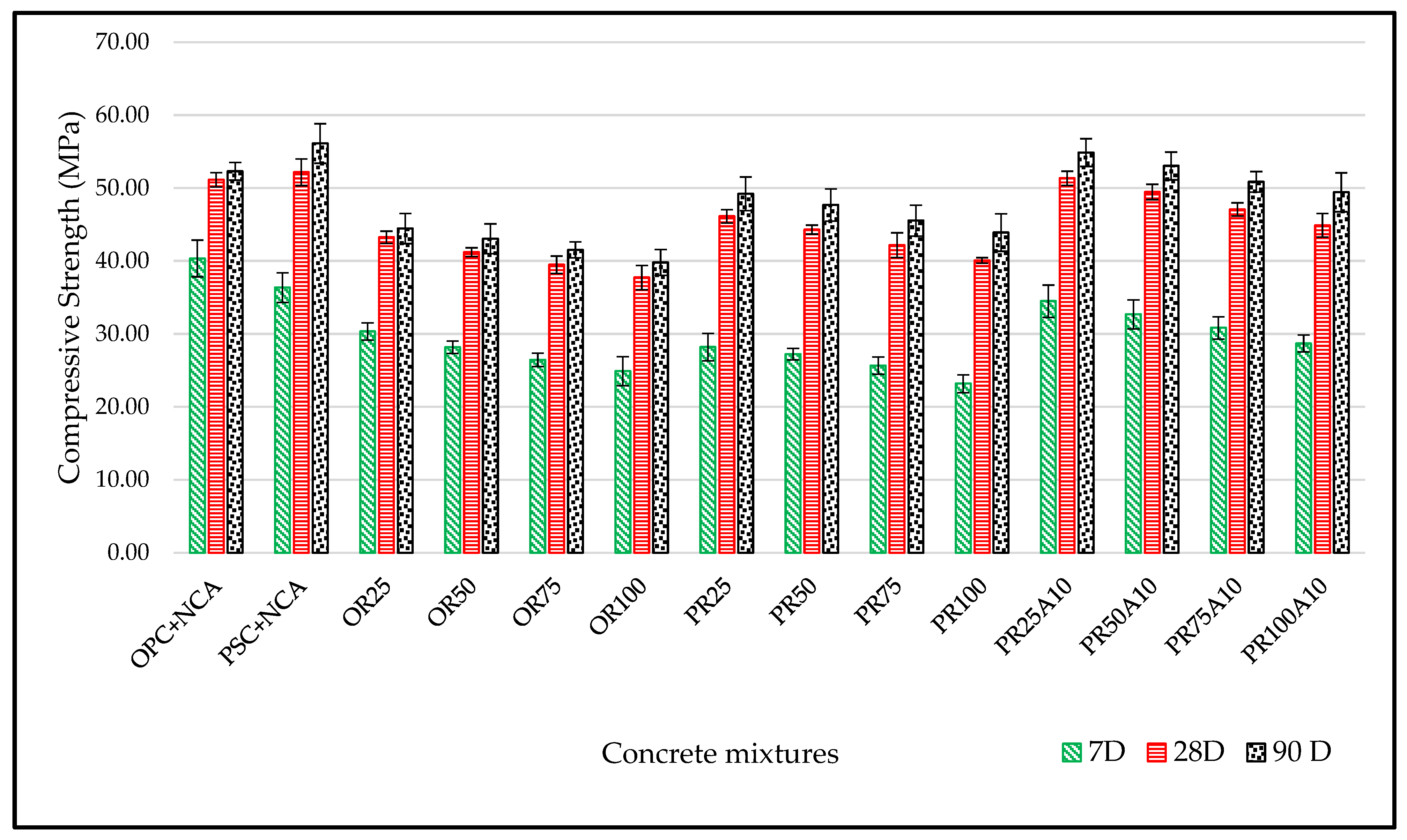
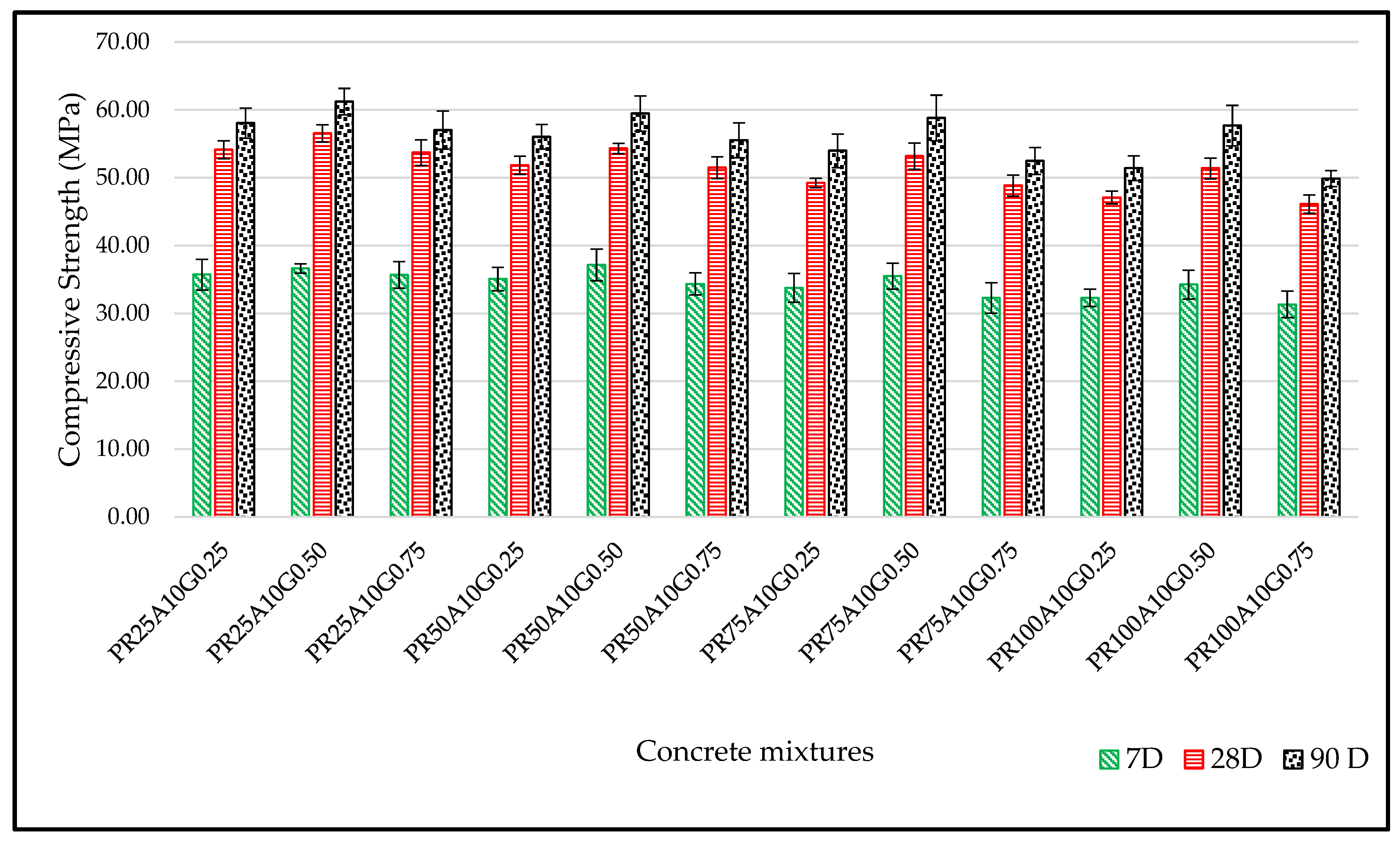

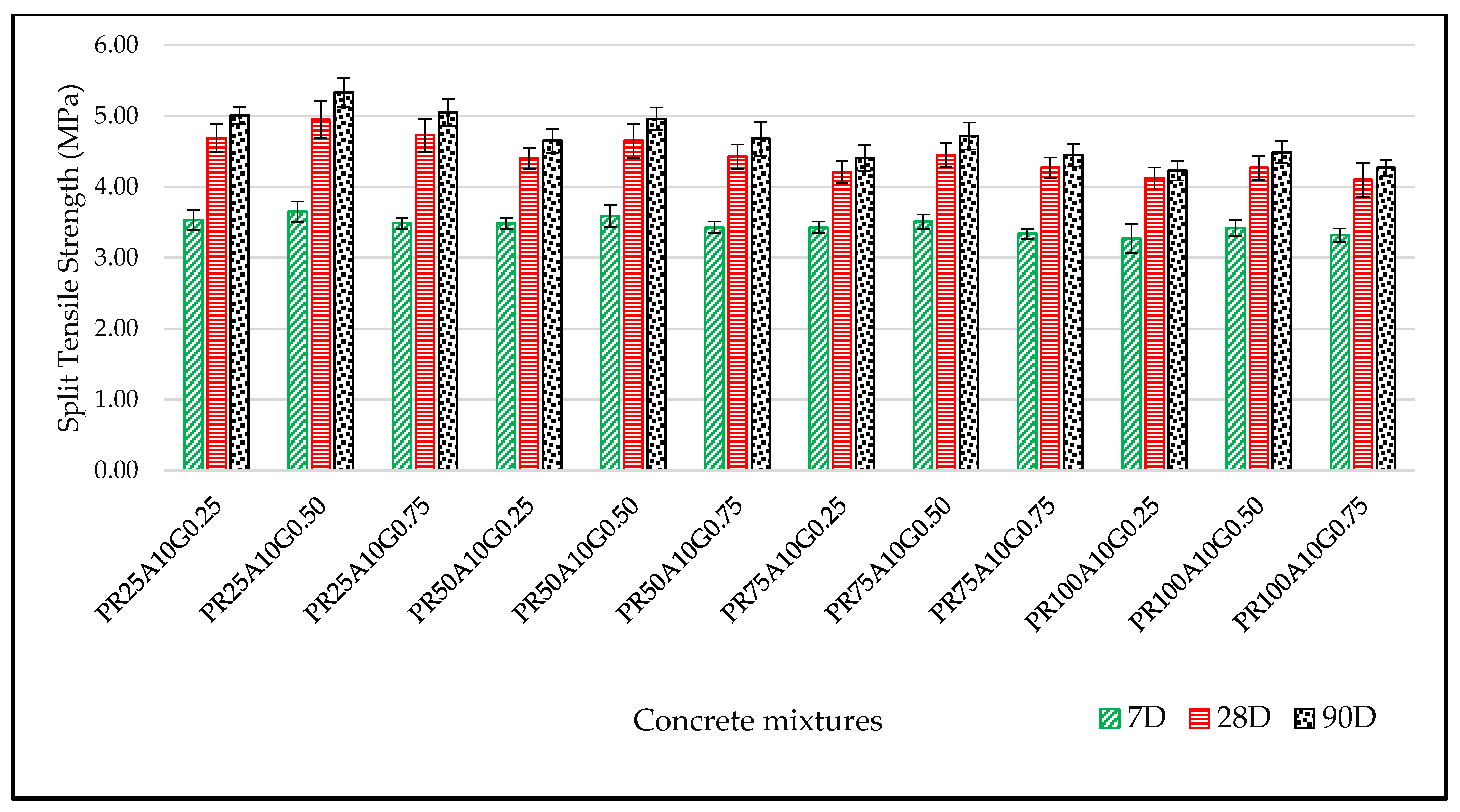
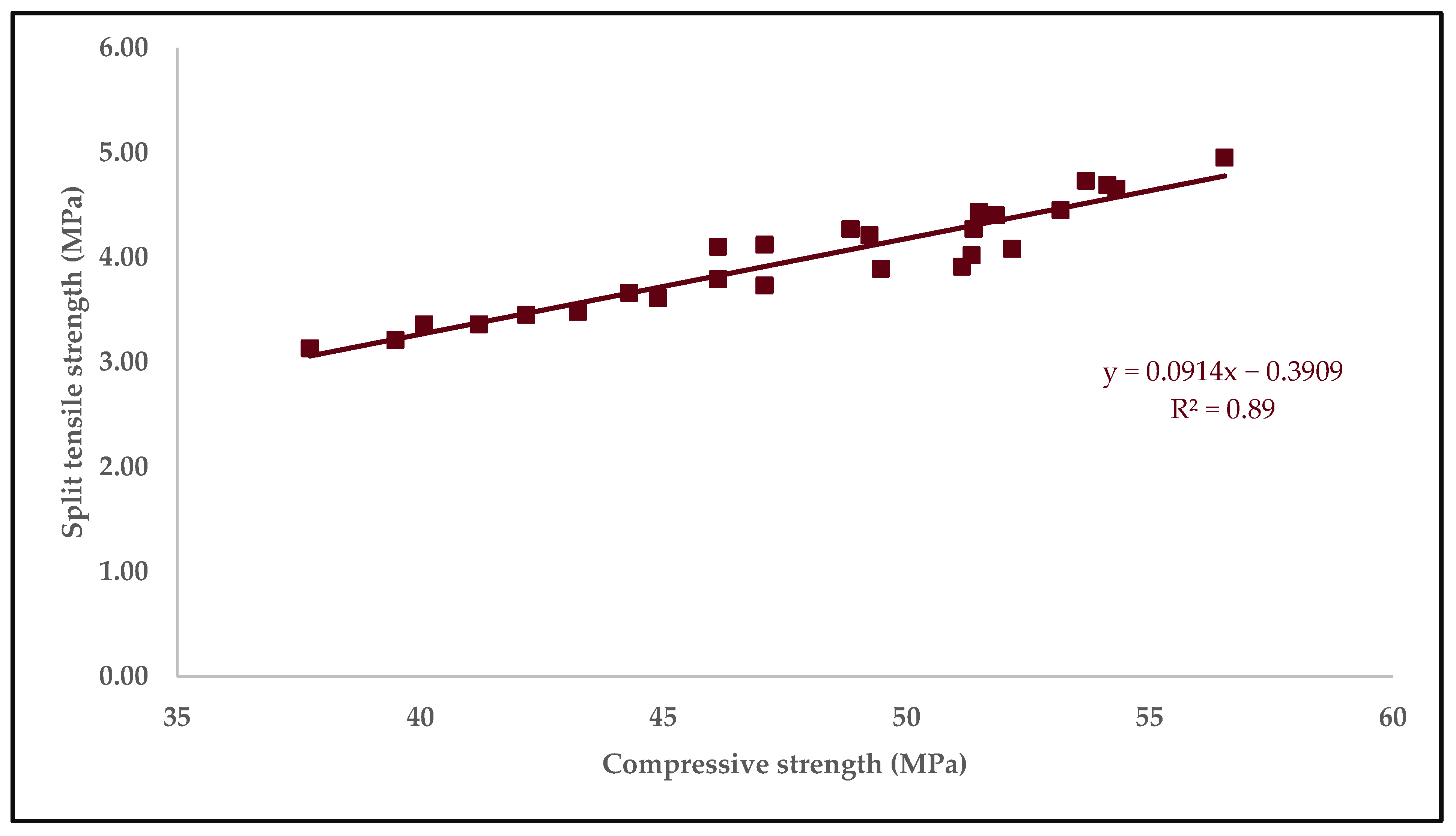
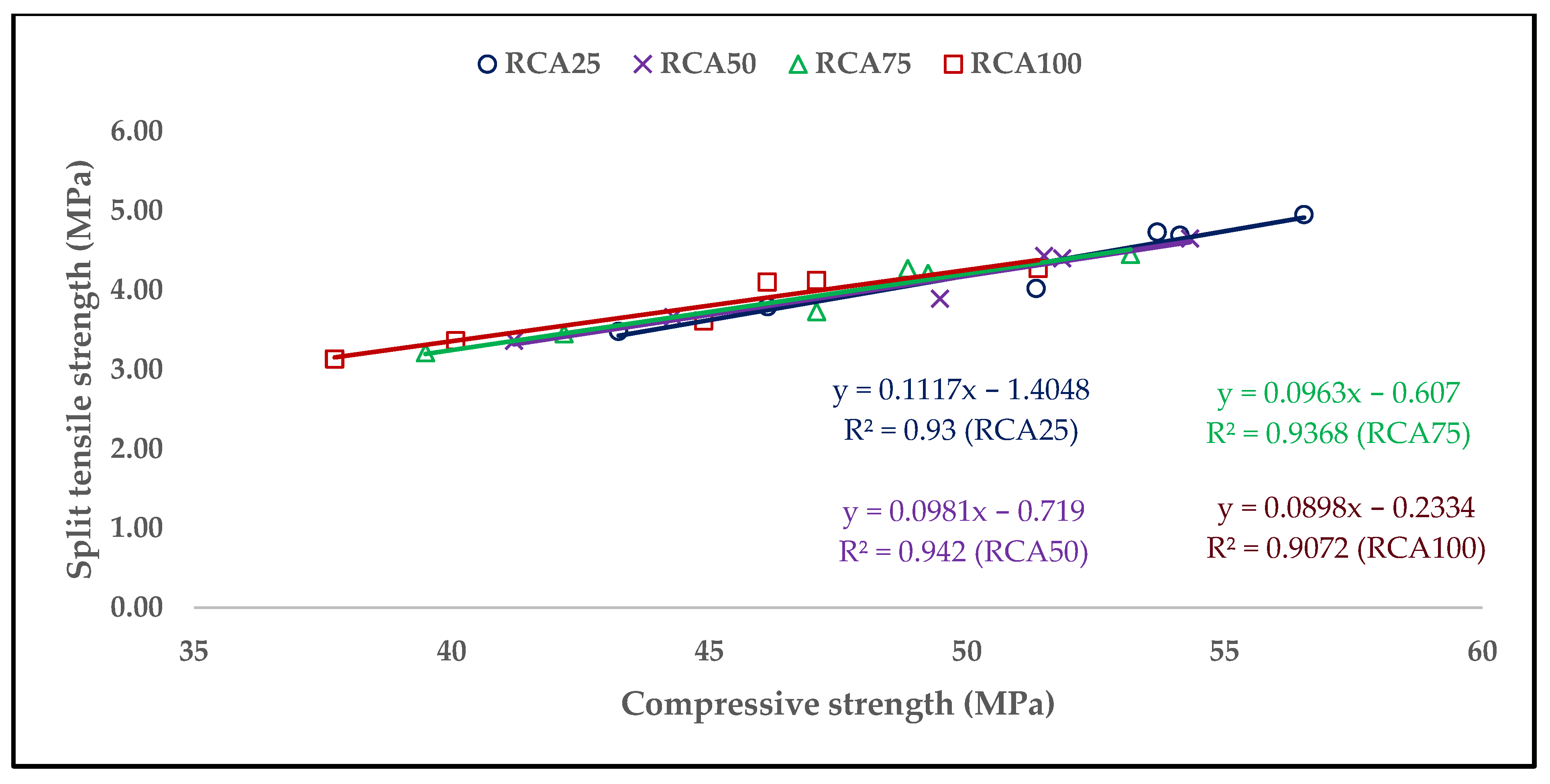

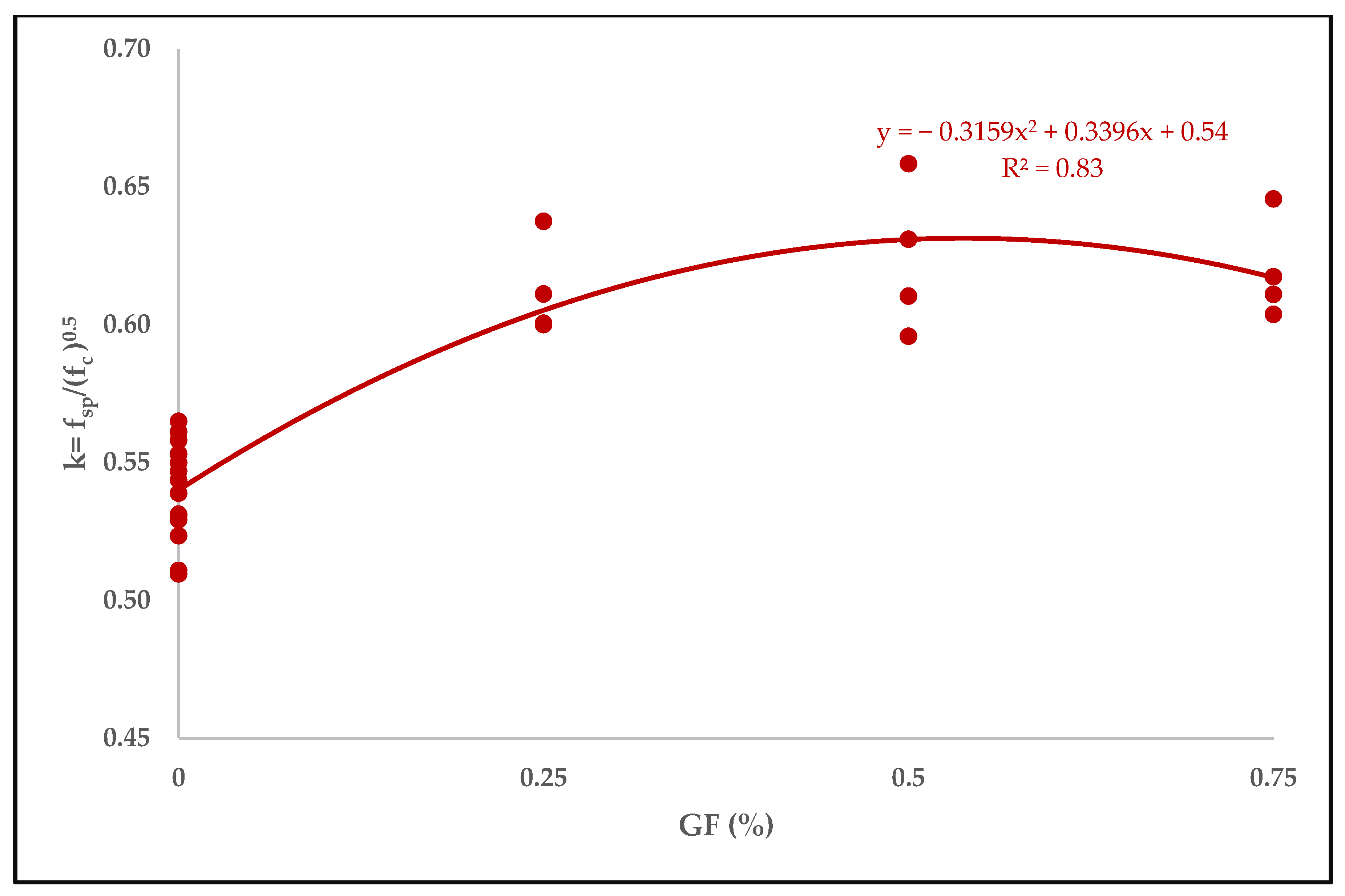
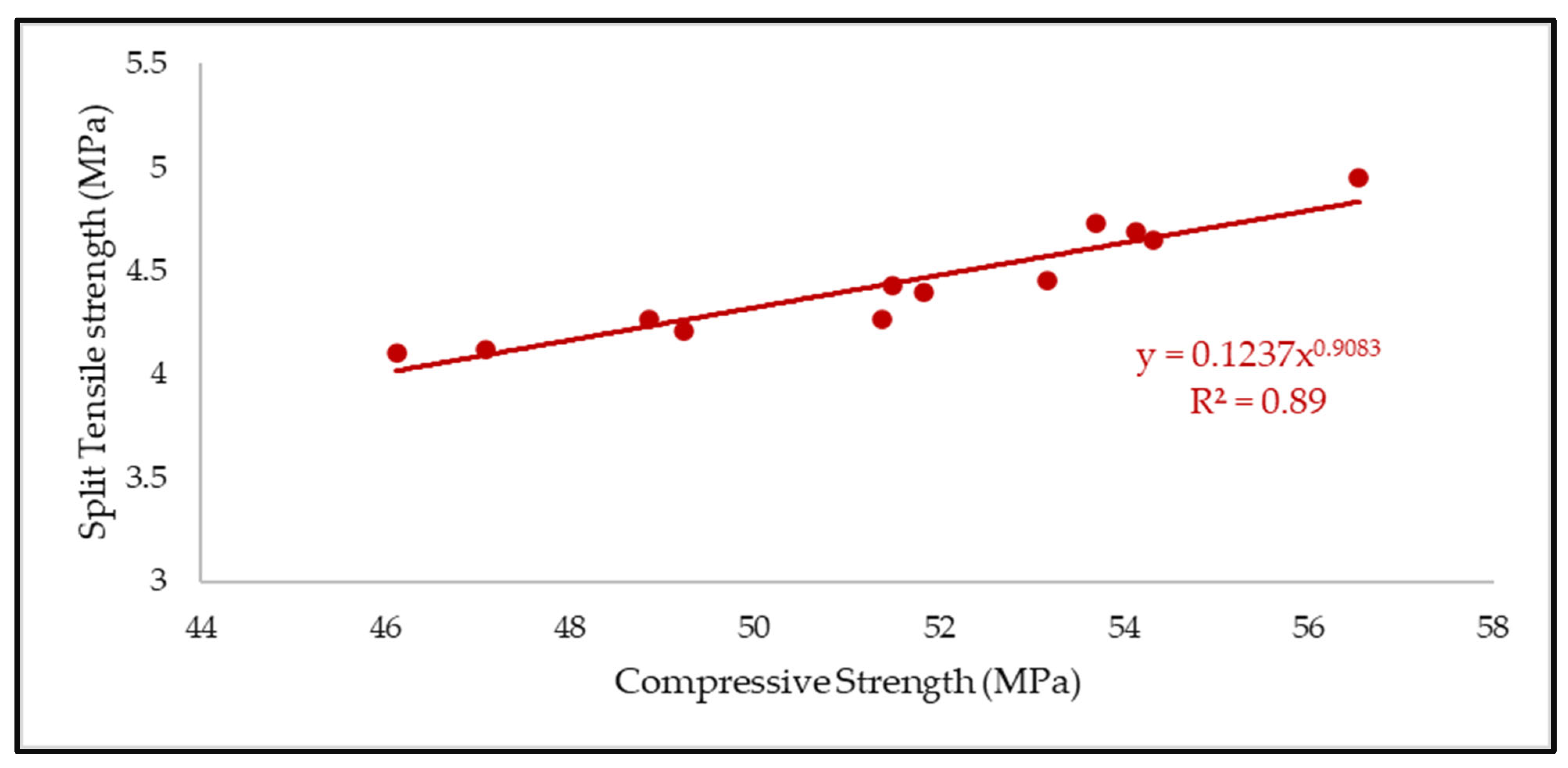

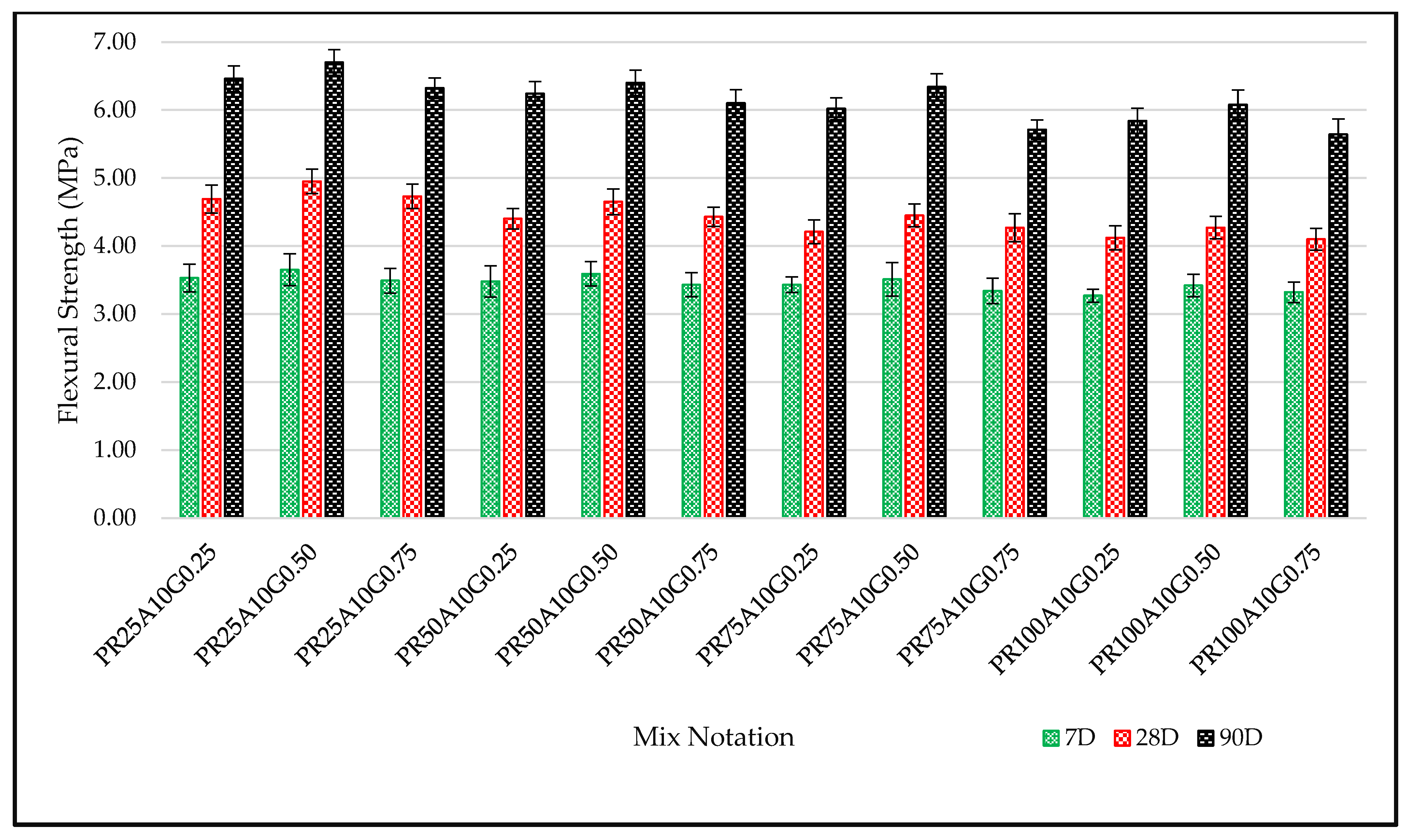
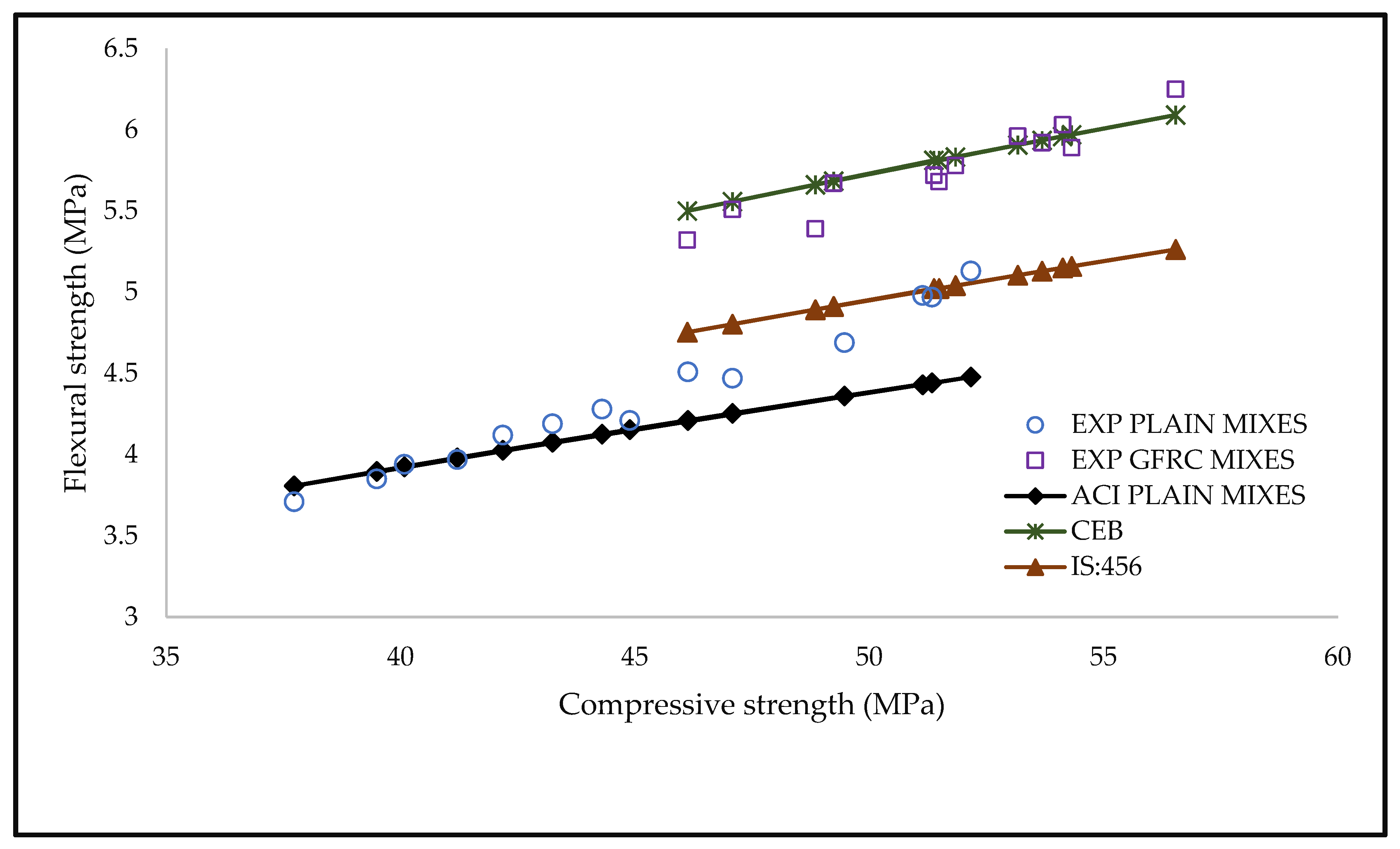


| Type of Aggregate | Maximum Deployment | ||
|---|---|---|---|
| Plain Concrete (%) | Reinforced Concrete (%) (up to M 25 Grade Only) | Lean Concrete (%) (<M 15) | |
| Recycled concrete aggregate (RCA) | 25 | 20 | 100 |
| Property | Experimental Value of PSC | Requirement of IS 455- PSC | Experimental Value of OPC | Requirement of IS 12269-OPC 53 |
|---|---|---|---|---|
| Fineness (%) | 7 | <10 | 8 | <10 |
| Normal Consistency % | 32 | - | 31 | 30–35 |
| Specific Gravity | 3.01 | - | 3.14 | 3.10–3.15 |
| Soundness by Le-chatlier expansion in mm | 1 | ≤10 | 1 | ≤10 |
| Initial setting time (IST) in min | 170 | ≥30 | 35 | ≥30 |
| Final setting time (FST) in min | 215 | ≤600 | 178 | ≤600 |
| Compressive Strength in MPa | ||||
| 3 days (minimum) | 25.30 | 16 | 29.34 | 27 |
| 7 days (minimum) | 36.35 | 22 | 40.34 | 37 |
| 28 days (minimum) | 52.17 | 33 | 51.14 | 53 |
| Chemical Analysis | Cao | Al2O3 | SiO2 | MgO | Fe2O3 | SO3 |
|---|---|---|---|---|---|---|
| OPC | 64.63 | 5.60 | 21.29 | 2.06 | 3.35 | 2.15 |
| Alccofine-C-1203 [21] | 28.54 | 36.75 | 28.64 | - | 1.167 | 0.14 |
| Characteristic | Referred to | NCA | RCA | IS: 383 Limit |
|---|---|---|---|---|
| Loose bulk density (kg·m−3) | IS: 2386 (part 3) | 1450 | 1310 | - |
| Compact bulk density (kg·m−3) | IS: 2386 (part 3) | 1565 | 1440 | - |
| Specific gravity—20 mm, 10 mm | IS: 2386 (part 3) | 2.68, 2.62 | 2.45, 2.24 | 2.4–2.9 |
| Water absorption (%)—20 mm, 10 mm | IS: 2386 (part 3) | 0.21, 0.14 | 3.40, 5.53 | Max 2% |
| Impact value (%) | IS: 2386 (part 4) | 13 | 25 | 45 |
| Abrasion value (%) | IS: 2386 (part 4) | 16 | 31.6 | 50 |
| Crushing value (%) | IS: 2386 (part 4) | 12 | 22 | 45 |
| Parameter | Result |
|---|---|
| Length of fiber (mm) | 12 |
| Diameter (µ) | 14 |
| Density (g·cm−3) | 2.70 |
| Modulus of Elasticity (GPa) | 72 |
| Tensile Strength (MPa) | 1700 |
| Chemical Resistance | Very high |
| Thermal conductivity | Very low |
| Specific Gravity | 2.60 |
| Series | Notation | Expansion of Notation |
|---|---|---|
| N | ON | Concrete with OPC and NCA |
| PN | Concrete with PSC and NCA | |
| OR | OR25 | Concrete with OPC and RCA 25% |
| OR50 | Concrete with OPC and RCA 50% | |
| OR75 | Concrete with OPC and RCA 75% | |
| OR100 | Concrete with OPC and RCA 100% | |
| PR25 | PR25 | Concrete with PSC and RCA 25% |
| PR25A10 | Concrete with PSC and RCA 25% + Alccofine C-1203 10% | |
| PR25A10G0.25 | Concrete with PSC and RCA 25% + Alccofine C-1203 10% + Glass Fiber 0.25% | |
| PR25A10G0.50 | Concrete with PSC and RCA 25% + Alccofine C-1203 10% + Glass Fiber 0.50% | |
| PR25A10G0.75 | Concrete with PSC and RCA 25% + Alccofine C-1203 10% + Glass Fiber 0.75% | |
| PR50 | PR50 | Concrete with PSC and RCA 50% |
| PR50A10 | Concrete with PSC and RCA 50% + Alccofine C-1203 10% | |
| PR50A10G0.25 | Concrete with PSC and RCA 50% + Alccofine C-1203 10% + Glass Fiber 0.25% | |
| PR50A10G0.50 | Concrete with PSC and RCA 50% + Alccofine C-1203 10% + Glass Fiber 0.50% | |
| PR50A10G0.75 | Concrete with PSC and RCA 50% + Alccofine C-1203 10% + Glass Fiber 0.75% | |
| PR75 | PR75 | Concrete with PSC and RCA 75% |
| PR75A10 | Concrete with PSC and RCA 75% + Alccofine C-1203 10% | |
| PR75A10G0.25 | Concrete with PSC and RCA 75% + Alccofine C-1203 10% + Glass Fiber 0.25% | |
| PR75A10G0.50 | Concrete with PSC and RCA 75% + Alccofine C-1203 10% + Glass Fiber 0.50% | |
| PR75A10G0.75 | Concrete with PSC and RCA 75% + Alccofine C-1203 10% + Glass Fiber 0.75% | |
| PR100 | PR100 | Concrete with PSC and RCA 100% |
| PR100A10 | Concrete with PSC and RCA 100% + Alccofine C-1203 10% | |
| PR100A10G0.25 | Concrete with PSC and RCA 100% + Alccofine C-1203 10% +Glass Fiber 0.25% | |
| PR100A10G0.50 | Concrete with PSC and RCA 100% + Alccofine C-1203 10% +Glass Fiber 0.50% | |
| PR100A10G0.75 | Concrete with PSC and RCA 100% + Alccofine C-1203 10% +Glass Fiber 0.75% |
| Mix ID | Cement (kg) | Alcco-Fine C-1203 (kg) | FA (kg) | NCA 20 mm (kg) | NCA 10 mm (kg) | RCA 20 mm (kg) | RCA 10 mm (kg) | Water (kg) | Glass Fiber (%) |
|---|---|---|---|---|---|---|---|---|---|
| OPC + NCA | 390 | 0 | 698 | 867 | 283 | 0 | 0 | 157 | 0 |
| PSC + NCA | 390 | 0 | 698 | 867 | 283 | 0 | 0 | 157 | 0 |
| OR25 | 390 | 0 | 698 | 650.25 | 212.25 | 191.25 | 57 | 157 | 0 |
| OR50 | 390 | 0 | 698 | 433.5 | 141.5 | 382.5 | 114 | 157 | 0 |
| OR75 | 390 | 0 | 698 | 216.75 | 70.75 | 573.75 | 171 | 157 | 0 |
| OR100 | 390 | 0 | 698 | 0 | 0 | 765 | 228 | 157 | 0 |
| PR25 | 390 | 0 | 698 | 650.25 | 212.25 | 191.25 | 57 | 157 | 0 |
| PR50 | 390 | 0 | 698 | 433.5 | 141.5 | 382.5 | 114 | 157 | 0 |
| PR75 | 390 | 0 | 698 | 216.75 | 70.75 | 573.75 | 171 | 157 | 0 |
| PR100 | 390 | 0 | 698 | 0 | 0 | 765 | 228 | 157 | 0 |
| PR25A10 | 351 | 39 | 698 | 650.25 | 212.25 | 191.25 | 57 | 157 | 0 |
| PR50A10 | 351 | 39 | 698 | 433.5 | 141.5 | 382.5 | 114 | 157 | 0 |
| PR100A10 | 351 | 39 | 698 | 0 | 0 | 765 | 228 | 157 | 0 |
| PR25A10G0.25 | 351 | 39 | 698 | 650.25 | 212.25 | 191.25 | 57 | 157 | 0.25 |
| PR25A10G0.50 | 351 | 39 | 698 | 650.25 | 212.25 | 191.25 | 57 | 157 | 0.50 |
| PR25A10G0.75 | 351 | 39 | 698 | 650.25 | 212.25 | 191.25 | 57 | 157 | 0.75 |
| PR50A10G0.25 | 351 | 39 | 698 | 433.5 | 141.5 | 382.5 | 114 | 157 | 0.25 |
| PR50A10G0.50 | 351 | 39 | 698 | 433.5 | 141.5 | 382.5 | 114 | 157 | 0.50 |
| PR50A10G0.75 | 351 | 39 | 698 | 433.5 | 141.5 | 382.5 | 114 | 157 | 0.75 |
| PR75A10G0.25 | 351 | 39 | 698 | 216.75 | 70.75 | 573.75 | 171 | 157 | 0.25 |
| PR75A10G0.50 | 351 | 39 | 698 | 216.75 | 70.75 | 573.75 | 171 | 157 | 0.50 |
| PR75A10G0.75 | 351 | 39 | 698 | 216.75 | 70.75 | 573.75 | 171 | 157 | 0.75 |
| PR100A10G0.25 | 351 | 39 | 698 | 0 | 0 | 765 | 228 | 157 | 0.25 |
| PR100A10G0.50 | 351 | 39 | 698 | 0 | 0 | 765 | 228 | 157 | 0.50 |
| PR100A10G0.75 | 351 | 39 | 698 | 0 | 0 | 765 | 228 | 157 | 0.75 |
| Experimental | Predicted fsp (MPa) | |||||||
|---|---|---|---|---|---|---|---|---|
| fc (MPa) | fsp (MPa) | Equation (3) | Equation (4) | ACI [37] | CEB [42] | IS: 456 [43] | Hilles and Ziara [46] | Ali and Qureshi [38] |
| 54.13 | 6.03 | 5.95 | 5.97 | 4.56 | 5.96 | 5.15 | 6.19 | 6.34 |
| 56.54 | 6.25 | 6.11 | 6.17 | 4.66 | 6.09 | 5.26 | 6.32 | 6.61 |
| 53.69 | 5.92 | 5.80 | 5.94 | 4.54 | 5.94 | 5.13 | 6.16 | 6.30 |
| 51.84 | 5.78 | 5.82 | 5.79 | 4.46 | 5.83 | 5.04 | 6.05 | 6.09 |
| 54.32 | 5.89 | 5.99 | 5.99 | 4.57 | 5.97 | 5.16 | 6.20 | 6.37 |
| 51.49 | 5.68 | 5.68 | 5.76 | 4.45 | 5.81 | 5.02 | 6.03 | 6.05 |
| 49.24 | 5.67 | 5.67 | 5.58 | 4.35 | 5.68 | 4.91 | 5.90 | 5.81 |
| 53.17 | 5.96 | 5.92 | 5.90 | 4.52 | 5.91 | 5.10 | 6.13 | 6.24 |
| 48.85 | 5.39 | 5.53 | 5.55 | 4.33 | 5.66 | 4.89 | 5.88 | 5.76 |
| 47.08 | 5.51 | 5.55 | 5.40 | 4.25 | 5.56 | 4.80 | 5.77 | 5.57 |
| 51.38 | 5.72 | 5.82 | 5.75 | 4.44 | 5.81 | 5.02 | 6.03 | 6.04 |
| 46.12 | 5.32 | 5.37 | 5.32 | 4.21 | 5.50 | 4.75 | 5.71 | 5.46 |
| IAE (%) | 1.23 | 1.16 | 22.80 | 1.69 | 12.83 | 4.69 | 5.09 | |
Disclaimer/Publisher’s Note: The statements, opinions and data contained in all publications are solely those of the individual author(s) and contributor(s) and not of MDPI and/or the editor(s). MDPI and/or the editor(s) disclaim responsibility for any injury to people or property resulting from any ideas, methods, instructions or products referred to in the content. |
© 2023 by the authors. Licensee MDPI, Basel, Switzerland. This article is an open access article distributed under the terms and conditions of the Creative Commons Attribution (CC BY) license (https://creativecommons.org/licenses/by/4.0/).
Share and Cite
Govardhan, C.; Gayathri, V. Experimental Investigation on Ternary Blended Recycled Aggregate Concrete Using Glass Fibers. Buildings 2023, 13, 1961. https://doi.org/10.3390/buildings13081961
Govardhan C, Gayathri V. Experimental Investigation on Ternary Blended Recycled Aggregate Concrete Using Glass Fibers. Buildings. 2023; 13(8):1961. https://doi.org/10.3390/buildings13081961
Chicago/Turabian StyleGovardhan, Cheetirala, and Venkataraman Gayathri. 2023. "Experimental Investigation on Ternary Blended Recycled Aggregate Concrete Using Glass Fibers" Buildings 13, no. 8: 1961. https://doi.org/10.3390/buildings13081961





